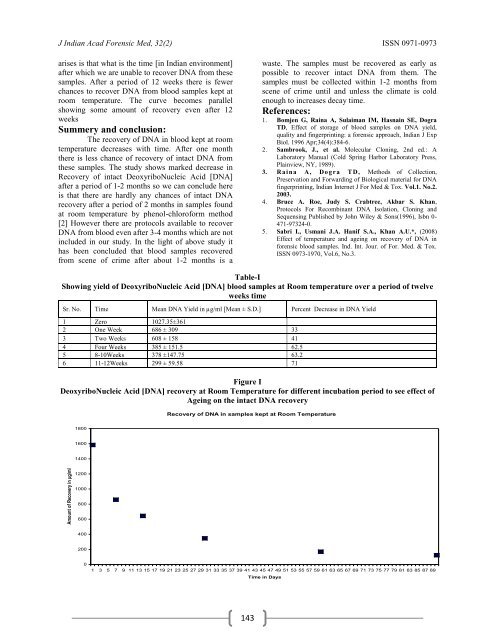jiafm, 2010-32(2) april-june. - forensic medicine
jiafm, 2010-32(2) april-june. - forensic medicine
jiafm, 2010-32(2) april-june. - forensic medicine
- No tags were found...
Create successful ePaper yourself
Turn your PDF publications into a flip-book with our unique Google optimized e-Paper software.
Amount of Recovery in µg/mlJ Indian Acad Forensic Med, <strong>32</strong>(2) ISSN 0971-0973arises is that what is the time [in Indian environment]after which we are unable to recover DNA from thesesamples. After a period of 12 weeks there is fewerchances to recover DNA from blood samples kept atroom temperature. The curve becomes parallelshowing some amount of recovery even after 12weeksSummery and conclusion:The recovery of DNA in blood kept at roomtemperature decreases with time. After one monththere is less chance of recovery of intact DNA fromthese samples. The study shows marked decrease inRecovery of intact DeoxyriboNucleic Acid [DNA]after a period of 1-2 months so we can conclude hereis that there are hardly any chances of intact DNArecovery after a period of 2 months in samples foundat room temperature by phenol-chloroform method[2] However there are protocols available to recoverDNA from blood even after 3-4 months which are notincluded in our study. In the light of above study ithas been concluded that blood samples recoveredfrom scene of crime after about 1-2 months is awaste. The samples must be recovered as early aspossible to recover intact DNA from them. Thesamples must be collected within 1-2 months fromscene of crime until and unless the climate is coldenough to increases decay time.References:1. Bomjen G, Raina A, Sulaiman IM, Hasnain SE, DograTD, Effect of storage of blood samples on DNA yield,quality and fingerprinting: a <strong>forensic</strong> approach, Indian J ExpBiol. 1996 Apr;34(4):384-6.2. Sambrook, J., et al. Molecular Cloning, 2nd ed.: ALaboratory Manual (Cold Spring Harbor Laboratory Press,Plainview, NY, 1989).3. Ra ina A, Do g ra TD, Methods of Collection,Preservation and Forwarding of Biological material for DNAfingerprinting, Indian Internet J For Med & Tox. Vol.1. No.2.2003.4. Bruce A. Roe, Judy S. Crabtree, Akbar S. Khan,Protocols For Recombinant DNA Isolation, Cloning andSequensing Published by John Wiley & Sons(1996), Isbn 0-471-97<strong>32</strong>4-0.5. Sabri I., Usmani J.A. Hanif S.A., Khan A.U.*, (2008)Effect of temperature and ageing on recovery of DNA in<strong>forensic</strong> blood samples. Ind. Int. Jour. of For. Med. & Tox.ISSN 0973-1970, Vol.6, No.3.Table-IShowing yield of DeoxyriboNucleic Acid [DNA] blood samples at Room temperature over a period of twelveweeks timeSr. No. Time Mean DNA Yield in µg/ml [Mean ± S.D.] Percent Decrease in DNA Yield1 Zero 1027.35±3612 One Week 686 ± 309 333 Two Weeks 608 ± 158 414 Four Weeks 385 ± 151.5 62.55 8-10Weeks 378 ±147.75 63.26 11-12Weeks 299 ± 59.58 71Figure IDeoxyriboNucleic Acid [DNA] recovery at Room Temperature for different incubation period to see effect ofAgeing on the intact DNA recoveryRecovery of DNA in samples kept at Room Temperature1800160014001200100080060040020001 3 5 7 9 11 13 15 17 19 21 23 25 27 29 31 33 35 37 39 41 43 45 47 49 51 53 55 57 59 61 63 65 67 69 71 73 75 77 79 81 83 85 87 89Time in Days143



![syllabus in forensic medicine for m.b.b.s. students in india [pdf]](https://img.yumpu.com/48405011/1/190x245/syllabus-in-forensic-medicine-for-mbbs-students-in-india-pdf.jpg?quality=85)



![SPOTTING IN FORENSIC MEDICINE [pdf]](https://img.yumpu.com/45856557/1/190x245/spotting-in-forensic-medicine-pdf.jpg?quality=85)

![JAFM-33-2, April-June, 2011 [PDF] - forensic medicine](https://img.yumpu.com/43461356/1/190x245/jafm-33-2-april-june-2011-pdf-forensic-medicine.jpg?quality=85)



![JIAFM-33-4, October-December, 2011 [PDF] - forensic medicine](https://img.yumpu.com/31013278/1/190x245/jiafm-33-4-october-december-2011-pdf-forensic-medicine.jpg?quality=85)


